
home

maglog

email

archive

radio

viridian

links

me
|
The extremely digestible

second quarter
first
quarter - third quarter - fourth quarter
my fave = my
fave
 |
WIRED
Magazine : June, 2000
There are issues of Wired
l like and there are those that I hate. I hate this one. But that's because
I have little interest in stock funds, much less the Wired Index Fund -
which is written up as one big ' I told you so'. This issue also describes
the Silicon Allee of Paris without telling us why we should care. The third
strike is another profile on how some in Hollywood are looking to the Net.
So why did I even pick up this issue in the first place? Well, I noted
that there were pieces on Pirate Radio, Nike's 'Digital Skunk Works', and
a profile of designer Bruce Mau so I thought it could be salvageable. It
wasn't so. |
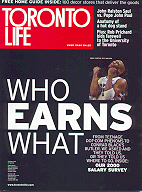 |
Toronto
Life: June 2000
We live in strange times
in which you talk pretty much talk about anything. Anything, that is, except
how much how you pull in as your salary. And it is for this reason why
Toronto's Life's seven pages of 'Who Earns What' is so oddly facinating.
There's not much else in this issue other than a profile of the University
of Toronto's outgoing president, Rob Prichard and a sad story of 'a poster
boy of rehabilitation' who got into fraud at the top of his game and lost
everything. Well, that's not exactly true - there are lots of other bits
but they are only of interest to those who live a Toronto Life. |
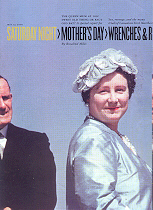 |
Saturday
Night : May 13, 2000
I had just sent off my check
for another year's worth of SatNite magazine and was in the process of
patiently waiting for the next issue when I read in my local paper that
SatNite was to assimilated into the National Post newspaper. Alarmed about
the status of one of my favorite mags (and my check), I picked up a copy.
Based on the debut issue, things seem ok. Lynn Crosbie (who wrote
my
fave hockey poem) writes about hockey violence from a fan's point of
view. There's also a fine piece on the complexities of the Queen Mother,
who turns 100 this year. Other works include another story about Canadian
Tire's Martha Billes, Bruce Mau's new multimedia work, and an interview
with Saul Bellow. The fashion section is new and is awful. So far, so good
but according to Frank Magazine, there is some troubling news. First, SatNite
has been losing more than $3 million a year and second, the freelance rates
have been set at 'newspaper' rates - not the standard $1 an hour. I'm not
subscribing to the National Post just yet, thank you. Now where's my check? |
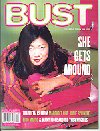 |
Bust:
Spring 00
Bust is "The Voice of the
New Girl Order" and in this issue this voice is saying, "pack yer bags,
girl, and hit the road!" The theme is travel and to my eye there wasn't
as many articles dedicated to the topic as in issues past, but that's ok;
I don't mind quality over quantity. Quality travel articles include a how-to
on packing, a bus travelogue, an ode to a bike, and stories about a near-death
experience in Greece, a break-up in Paris, drinking in LA, sitting in first
class while looking like a floozy, and on being pregnant while traveling
in south asia. Margret Cho is on the cover and she's interviewed in the
pages within as is Cibo Mato and Annie Sprinkle. When you're off on your
summer vacation this year, don't forget to pack your Bust. You must. You
must. |
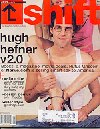 |
Shift
Magazine: June 2000
I really enjoyed this issue
of Shift and with it I think the magazine has really hit its stride in
becoming the magazine "for living in digital culture". The article on Nerve.com
is an ok piece on smut and branding as is the profile on girlshop.com
which falls more along the lines of fashion and branding. But my favourite
articles were the thoughful pieces on the top-down creation of an Eastern
silicon valley in Cyberjaya, Malaysia and
the profile on digital designer John Maeda.
I think the appeal for Shift for me is that they are trying to attract
an audience that is interested in the ramifications of the digital that
is outside of their stock portfolios. |
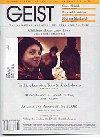 |
Geist:
Number 36
Some days I wake up and
I can't bare the thought of having to read about the new economy or the
new media or whatever new bill of goods has been set upon us. On those
days, work like Geist make me grow fond of humanity again. Geist is filled
with accounts of the sort of poetic moments that give you pause in an otherwise
boring day. Like losing your wallet in Lisbon, or watching a child lonely
for her mother play, or learning of the uber-frugal on Bay Street.
And Geist is saucy. This issue is filled with hockey
sauciness: love poems dedicated to Pavel Bure and Wayne Gretsky,
french hockey terms (the penalty bench = le cachot or the prison),
terms for 'self-stimulation' (pulling the goalie), some precursors to the
term hockey (oochamkumutk), photographs of gay hockey players, an
African hockey poem, and a dissection of the Hockey Hall of Fame. Geist
has a clean and beautiful design too. Geist is Neist. |
 |
Harper's
Magazine: June 2000
Harper's celebrates it's
150th birthday with a letter of congratulation from Bill Clinton and 184
pages of wordy goodness. I haven't made a dent in it yet so I'm just
going to reprint its table of contents and perhaps flesh out this review
later on. The Readings section features short takes from Nancy Reagan,
Mark Twain, Jorge Luis Borges, Glenn Gould, Gertrude Stein and Orson Welles,
among others. The Folio is penned by editor Lewis Lapham and is about Harper's
magazine, then and now. Tom Wolfe offers an essay on why no one is celebrating
the second American century and other essays are offered by Russell Banks,
Mark Slouka, Thomas Lynch and Jane Smiley. And for a little bit of a retrospective
there are reprints from Harper's Magazine in 1850. Our eyes are always
trained on the horizon. It's a rare thing to take a look back and to see
what ground we've covered. |
 |
Utne
Reader: May - June 2000
I was disappointed with
this issue of Utne. Not because it put a celebrity on the cover (which
the editor did with some trepidation) but because Utne really didn't flesh
out the idea of fame and celebrity as well as they could. Instead, they
just added a couple of lame fame-related article around one
really good article on the topic by Cintra Wilson. I think they
also gave short shrift to another one of my favourite topics, cognitive
mapping, or, in Utne-speak: "Sacred Cartography". Perhaps I'm being unfair
as the Utne Reader is supposed to only provide samples of "The Best of
the Alternative Press". Other smorsgaborg items in the issue include an
account of suffering from a brain disease, preserving silence, how to listen,
managed care, and invisible Latinos. So while it may not always be filling,
Utne is often tasty. |
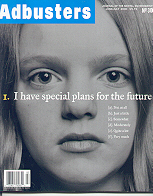 |
Adbusters:
June/July 2000
With this issue, Adbusters
really takes its to its moniker of "The Journal of the Mental Environment"
as it takes on the pharmaceutical industry. Adbusters diagnoses the American
psyche as suffering from clinical depression and doesn't prescribe Prozac
but self reflection, therapy, and perhaps some Eco-psychology. Mark Kingwell
weighs in on matters saying that our new machines have created a new flesh,
which will probably make sense to those who have seen Cronenberg's
Videodrome. The weakest article is the one that makes some great points
in describing the new activism only to reduce the phenomenon to GenX vs
Boomer attitudes. Another sore point for me is the brief article against
photographer Olivero Toscani's recent ad campaign for Benneton - the one
that features inmates on death row. I found the criticism odd because Adbusters
has previously expressed admiration for Toscani's co-worker, Tibor Kalman,
who pulled off a similar publicity stunt to promote Tibor's design agency
while raising awareness about the homeless problem in New York. Perhaps
I should write a letter and point this out because this issue also has
a really strong letters section that really takes the magazine to task
about its weaknesses. I like to think that one measure of a good magazine
is the letters section because its proof that the magazine has readers
that care to continue the dialogue. Harpers' has a great letters section,
and WIRED used to have one. And don't even get me started about The New
Yorker. |
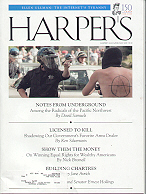 |
Harper's
Magazine: May 2000
I have already mentioned
in my blurb on Adbusters, that Harper's has a great letters section. There's
another point of comparison I'd like to make as both weigh in on the
new activism that has been making its mark (as does the April 17th
issue of the New Yorker I may add). In Harper's, the author travels to
Eugene, Oregon where on June 18, 1999 nearly 400 'black bloc' demonstrators
attacked banks and businesses as well as threw rocks at police. I
had never heard of this attack, although we all now know their anti-WTO
work in Seattle. The author paints an honest and largely sympathetic portrait
of these 'radicals' - (fave quote: "You can't help
wanting Nike sneakers. At the same time, the desire to smash the windows
of NikeTown makes sense too. Not because Nike sneakers are bad, or because
they are manufactured in Third World countries by slave-wage labor, but
on the more general principle that someone should be held responsible for
the feelings of absence and compulsion that overwhelm us all at some point...")
although he seems to make a strange correlation between environmentalism
and being a child of divorced parents. Other articles cover the rebranding
of England, the US government's favourite arms dealer, and how wealthy
Americans can win equal rights. The map of the Sydney
Olympic Site was also especially telling. |
 |
COLORS:
April-May 2000
Even though the theme of
this issue of Colors is prayer, there's not that much about religion in
its pages. Instead, the focus is on "What are you praying for?". So each
of 2-page photospread covers an idea such as comfort, love, power, an idol,
and good business. To add to this jumpiness, many of the images used in
this issue don't correspond with the info-tidbits that accompany them (what
I learned: 94% of beer in Ireland is drunk in pubs; 80% of beer
in the United States is drunk at home). I had once read that Colors
frequently makes use of stock photography to serve its needs and I'm guessing
that in this issue they might have gone overboard. I'm praying for a better
issue next time. |
 |
Civilization: May 2000
Ok. If Civilization is "The
Magazine of the Library of Congress", how come I don't know of any librarians
who read it or any library that subscribes to it? Well if when I flipped
through an issue, the answer became obvious: the magazine is geared to
the affluent. No kidding. There are ads for Jaguar and Lexus cars, Lousi
Boston suits, Permigiani watches, and Classic Malt whiskeys. Not exactly
the domain of your local public librarian. The Library of Congress (LoC)
angle is really just a front. But, to keep up with this pretence, this
issue of Civilization dedicates space to libraries in light of the LoC's
upcoming bicentennial. There are short articles on the Digital Library,
copyright law, folk knowledge, book preservation, and the Congressional
Research Service. Non-library features include articles on garage
biotech, Napa Valley, and Bolivar's continuing influence in Venezuela.
I don't mind that the LoC is sponsoring a publication that is not library-related.
I just wish the publication would be more library-like. |
 |
Esquire: May 2000
I've been meaning to read
Esquire for some time now, but I made myself wait until there was a cover
without some half-naked woman sprawled on it. I had high expectations since
Esquire had recently won some National Magazine
Awards and maybe it was because these expectations that led me to disappointment.
First off, some articles I just skipped or scanned out of lack of interest:
the profile of baseball manager Larry Dierker, the guy who gets his head
scanned for damage after 38 years of hard living and gets a clean bill
of health, the interview with Paul Newman, the interview with Andy Grove...
Now, I did find the David Letterman article fairly interesting - mostly
because I know little about the man. There was also a 'Restless Man' travelogue
which was really good and that told of a visit to Coiba, Panama: the last
penal colony on earth. But overall, my impression of Esquire is the same
as my preconception: it's more about style than ideas. |
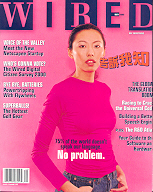 |
WIRED:
May 2000
If Language
is a Virus, then Language Translation Tools are what? Well, according
to WIRED they are all the rage and it does a nice job giving the history
and guessing the future of electronic translation and speech devices in
a series of related articles. The only downer of the series is the 'start-up'
story. Now I understand that the story of a start-up is a wonderful source
of human drama in an otherwise boring business setting, but they are all
beginning to sound the same to me. Instead, I recommend reading the article
about
a technology that may offset our dependence on toxic and unreliable batteries:
the lowly flywheel. Now that's a start-up I can root for. Filler
in this issue includes the 'hottest golf gear' and the deeply flawed, WIRED
Digital Citizen Survey. |
 |
Whole
Earth: Spring 2000
Think of Whole Earth as
WIRED's older hippie brother. Make that, an estranged older hippie brother
- they haven't seen eye to eye for some time. Both issues cover language
as a subject, but while WIRED looks at computers to translate for us, Whole
Earth looks at thousands of languages that may go extinct and the means
that some folk are undertaking to keep them alive (of the 6000 languages
still on earth, 90% could be gone by 2100). And while WIRED covers
start-ups, Whole Earth looks at the shut-down of the WTO and covers it
quite well, actually. Last issue WIRED covered the scientific exploration
of Lake Vostok in Antarctica. This issue, Whole Earth takes a more aesthetic
look at the world's loneliest continent and reproduces some breath-taking
photographs from the area. This Whole Earth also covers migrants who hunt
mushrooms, an argument to bring elephants back to North America, an examination
of "Homosexual / Transgendered Animals and Indigenous
Knowledge" (which showcases some fascinating scholarship and isn't
as flaky as it sounds), and grassroots radio. I love this magazine. |
 |
THIS:
March / April 2000
I've had the damnedest time
getting into this issue, probably because the subject matter is so serious.
THIS issue covers such topics as how unaccountable Canadian investments
are causing havoc and damage overseas, how a number of upcoming court cases
will have the potential to completely redefine Canada's government and
aboriginal relations, and THIS also looks at how the Ontario government,
through an unaccountable Ontario Realty Corporation, have been selling
off Ontario landmarks like the Oak Ridges Moraine in a very questionable
manner. Bummers, all around. Lighter fare includes an examination of straight-edge
punks and how our culture reflects a demonization (hello, Buffy?) of our
youth. I learned a great German word from this article: Kinderfeindlichkeit:
a society-wide hostility towards children. |
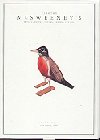 |
Timothy
McSweeney's: Late Winter 2000
If you are looking for this
issue on the newsstand, look for a cardboard box, about one inch deep.
If you buy it and take it home, you can open it to find that inside there
are 14 discrete, exquisite booklets. The contents of such are as follows
(for those items I haven't read yet, I've cribbed descriptions from the
TOC): 1. "Notes and Background" (notes and "The Author's and Book Enjoyer's
Bill of Rights"); 2. Threadworkers of the Seventeenth Century (a 'convergence'
of two paintings, a photography and a poem); 3. "A Chance Meeting" (an
essay about historical encounters); 4. "The Middle Tales" (five modern
fables); 5. "The Double Zero" (a story that supposedly is a version of
Sherwood Anderson's "The Egg"); 6. "Hellhound on My Trail" (a three act
play); 7. "Symmes Hole" ( a true story about a man who thought the world
hollow and inhabitable); 8. "Dabchick" (a short story involving passwords
and tunnels); 9. "Paperback Nabokov" (an essay about how Nabokov fought
for acceptable cover art); 10. "A Mown Lawn" (like poetry; word art); 11.
"Dar(e)apy" (twisted tale of a therapy that consists of choosing lesser
evils); 12. "K is for Fake" (a version of Kafka's 'The Trial'); 13. "Four
Institutional Monologues" (four monologues); and 14. "Shorter Stories"
(letters and short stories). You'll want to make sure that this is the
sort of thing that you would like to read because this issue McSweeney's
costs $22. US$. Is it worth it? As an art piece, yes. But for your reading
dollar, I'm not so sure. I loved the last
issue so much more, but perhaps that's because it contained much more
non-fiction which I profess, love above fiction and especially above difficult
fiction. |
 |
Shift:
May, 2000
This Shift is a yawn and
doesn't do funky coverboy Beck any justice. It's short pieces didn't tell
me anything I didn't already know about Lego, computers as landfill concerns,
medical privacy concerns, and that there are a lot of folks wearing khakis
in the office now. Ok, one thing that I didn't know until reading Shift
was that the former front man of the Finnish band, "The Lenningrad Cowboys"
is now creating content for the mobile-phone-mad Finns. The other longer
piece follows a failed actor who thinks he can the next e-millionare with
his plan take product placement one step further to the point-and-buy level.
It's sad, really. Then there's the online music guide: brief bios on the
creators of Sonic-Net, Napster, and MP3.com, a brief interview with Beck,
the '25 Top Net Radio Stations', and some places where you can buy vinyl
records on the web. I would have loved to see an article that would tell
me how I could turn my own computer into a radio station but I guess I
have to be content with lists instead. |
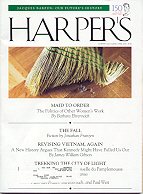 |
Harper's
Magazine: April, 2000
Last year, Barbara Ehrenreich
took a number of minimum wage jobs and wrote an insider's account of the
working poor in an excellent article in Harpers. This time, she has taken
a job with a maid agency to add first-hand experience to a piece about
maids and the politics of other women's work. In the piece she examines
the working conditions of maids and the privatization of the industry.
She also wonders if the recent demand for maids is a sign of the
'brazilification' of classes within the United States and the broader question,
what happens when your home becomes a workplace? For lighter fare, there
is a story about a couple go to Paris and who take on a new form of adventure
travel: traveling with a small child. The folio piece is fiction,
and this month's book review speculates that Kennedy may have pulled the
US out of Vietnam if he had lived through his term. |
 |
Brill's
Content April, 2000
No, Brill isn't content,
at least not with the state of media today. And not just because of all
the behemoths of media are merging together. One of the better articles
is an account about how a journalist in a small-town had a impossible time
writing about the industries that his publisher's family were involved
in. Another article that sheds light on how journalists do their jobs is
the cover peice about the libel lawsuit against the Atlanta Journal- Constitution
by Richard Jewell, the man who found the pipe bomb during the Atlanta Olympic
Games. He was first regarded as a hero but then suspicions were printed
that he was a suspected of planting the bomb himself. Were journalists
just doing their job or was there muckraking about? There's a lot of more
this sort of media-navel gazing: about college basketball sports reporters,
about TV puindit Bill Kristol, a debate on the survival of PBS, and about
scandal-tainted celebrity journalist Mike Barnicle. Brill's Content is
for hard-core pundit-watchers and journalists only. |
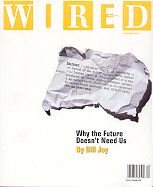 |
WIRED:
April, 2000
The cover story, by
the co-founder of Sun Microsystems, is a really weird article that's at
the very end of the magazine. I say it's weird, because Bill Joy first
writes that he's worried that his work may contribute to a future in which
we are ruled by robots (personally, I'm more afraid of polluted drinking
water and the greenhouse effect than being edged out by appliances). But
then, the article shifts from fear of robots to fear of biotechnology,
bio-terrorism and nuclear weapons - something that the cover art piece
doesn't really convey. Anyway, while the piece is earnest, it's not
really that good. That's too bad, cause most of the other articles in WIRED
are now following a familiar arc: "Can X (J. Walter Thompson ad agency,
Frank Biodini ex-head of Universal Studios) survive the Internet age? -
Looks good. But let's wait and see" The is one diamond in this rough: a
long piece about Lake Vostok - a recently
discovered lake buried under ice in the Antarctic. |
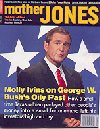 |
mother
jones: April 2000
There's an interview with
Jesse "From the Streets to Wall Street" Jackson and a profile by Molly
Ivins on Geoge "All Hat No Cattle" W. Bush which covers almost the exact
same ground as last month's Harper's. Well, that's not exactly true as
there was a second article that details how George W. applied political
pressure to push Huston-based Enron in a bid for an pipeline project in
Argentina. Hmm. It might be a good time to order the Mojo back issue of
Sept/Oct '92 which features this cover story: "Jeb Neil and George W. Bush's
Sleazy Business Deals: How the Bush Boys Made Millions by Cheating Taxpayres
& Investors". Non-Bush articles include an examination of seniors volunteering
in schools, a brief history of the strife in Northern Ireland, the turbulent
history of solar power, how the Pinochet indictment in England was a squandered
opportunity to address the past injustices of Chile, and an article
that tracked of a job lost in New Jersey (which paid less than $8.00 an
hour) that was gained in Mexico (which pays less than $8.00 a day). Just
like This Magazine, Mojo knows the importance of a clean design to convey
the ideas that corporate and consumer magazines won't touch such as "cheap
goods have a human cost". Get your Mojo working for you. |
 |
Popular
Mechanics: April 2000
I picked up Popular
Mechanics on a whim and the crazy thing is - I like it. The Technology
Watch
section was light and amusing ("Foamy Grout Stops Mine Fire"), there was
advice on how to save someone whose fallen through ice, a car column by
Jay Leno (!), an article about how the PopMech staff souped up a car to
find UFOs, the cover article which is actually about the contents of the
recently released 'Mitrokhin Archives' - something you might have already
heard about if you follow the British press, a how-to guide on turning
your PC into a high-def TV, eight home improvement how-tos, and lots of
stuff on cars and car-care. Right now, my dream magazine would a combination
of Bust, Baffler, Harper's, Might, and Popular Mechanics. |
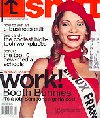 |
Shift:
April 2000
With all the techno-boosterism
these days, it's nice to see a cynical eye being cast on the I.T. industry.
Out of Shift's cynical eye, we follow the orientation of new employees
at Scient (which does looks suspiciously like a cult) and a profile of
Jamie Levy who's company is producing a webtoon (which looks suspiciously
like her own life) of a character who moves to Silicon Alley (that's in
New York, daarling), hangs around hipsters, and watches big business ruin
all what was fun about new media. As well, there's also a look at the (thankfully
declining) profession of "Booth Bunnies" (which sometimes reads as
an exploitation piece in itself). Shift also reviws the top 10 new-media
schools (1. MIT, 2. NYU, 3. Full Sail), and looks at how cops are portrayed
in video games. Nothing in this issue particularly rocked my world, but
the review of Yo La Tango's (which is mostly a diatribe against Beck) raised
my ire. Evidently, when Beck refers to pop culture he is being ironic,
but when Yo La Tango does it they are being sincere. It is these types
of arguments that makes me hate rock jounalism. |
first
quarter - third quarter - fourth quarter
the
rain barrel
extremely
digestible maglog
or
the
1999 rain barrel
extremely
digestible maglog archive
|




